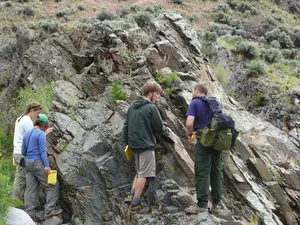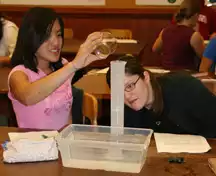Initial Publication Date: December 1, 2011
Inquiry and Discovery-based Projects Within Introductory Courses
Information compiled by Monica Bruckner, SERC
Jump down to: How to Incorporate Inquiry and Discovery-based Projects | Teaching Methods | Case Studies
Inquiry and discovery-based projects, including field studies and interactive laboratory activities, can engage introductory students, majors and non-majors alike. These activities appeal to the affective domain and develop students' metacognitive skills. Hands-on, inquiry-based projects in the field allow students to observe their environment and to apply their classroom knowledge to the real world. When combined with data collection, students are able to take this a step further and take ownership of the data they collect and learn how to analyze that data to make sense of Earth processes. When fieldwork is not an option, classroom-based inquiry and discovery-based projects in the laboratory or virtual learning environments can still help students to apply their knowledge from various disciplines to solve problems and to relate what they learn in class to real-world situations.
Benefits of Inquiry and Discovery-based Projects
There are many benefits tied to integrating inquiry and discovery-based projects into the classroom. These experiences tend to be interactive and engaging for students, engaging the affective domain, which generally increases students' motivation to learn, confidence in their ability to learn, and ultimately retention of knowledge and development of skills. In addition, here are several other benefits to using inquiry and discovery-based projects in the introductory-level classroom:- Students learn concepts more deeply than in lecture-based classes because they have more direct experience.
- Students gain a better understanding of the processes of scientific inquiry because they do primary research.
- Students learn field and lab skills that are difficult to incorporate into traditionally-scheduled classes.
- Student resumes are filled with evidence of skills, report writing, publications and professional presentations.
- Students make direct connections between understanding Earth systems and managing the actions of human society.
How to Incorporate Inquiry and Problem-based Learning into the Classroom
Whether you're designing a handful of activities or your entire course around integrating inquiry and discovery-based learning, these tips and considerations, compiled from the Undergraduate Research module, may aid in your success:- Identify your learning objectives and goals and design your activity around these. This will help solidify students' conception of why they are doing the work. Learn more about learning objectives.
- Determine your project needs. This may include considering the time commitment you need to carry out the project, both in and out of class; what types of instruments you will need; travel considerations for off-campus field projects; and depending on the nature of the project, whether you need your department or college's permission to carry out the project.
- Set expectations for both you and your students and provide proper scaffolding for the activity. Remember that intro students may not have all the background knowledge and skills required to complete the project without your help and that they may struggle with the process of science when things don't turn out as they intend or expect them to. Informing students about the process of science may help alleviate students' frustrations when things go unexpectedly. In addition, developing a rubric for assessment may aid in aligning your expectations with those of the students.
- Consider how much and what type of support you will provide your students. Students learn a great deal from problem-solving on their own and through trial and error, but in some cases, it may be beneficial to provide students with guidance to alleviate their frustration when things don't go as expected or if they are struggling with the next steps.
- Develop your assessment prior to the activity and make sure students understand how they will be assessed. Developing a rubric is one example of a straight-forward, organized way to do this.
- Extend the experience. This can be done through a classroom discussion of what students learned through the project, whether it is knowledge gained or skills developed. Students could also develop their presentation skills by disseminating their findings to others via a department seminar, a presentation at a professional meeting, or if it is a service learning experience, students can disseminate their findings to the community through a newspaper article or by giving a presentation.




